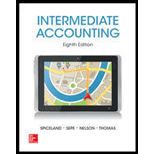
Concept explainers
Dollar-Value-LIFO: This method shows all the inventory figures at dollar price rather than units. Under this inventory method, the units that are purchased last are sold first. Thus, it starts from the selling of the units recently purchased and ending with the beginning inventory.
To Estimate: the ending inventory and cost of goods sold for 2016.
Explanation of Solution
Calculate the amount of estimated ending inventory and cost of goods sold for 2016.
| Details | Cost ($) | Retail ($) |
| Beginning inventory | 71,280 | 132,000 |
| Add: Net purchases | 112,500 | 255,000 |
| Net markups | 6,000 | |
| Less: Net markdowns | (11,000) | |
| Goods available for sale – Excluding beginning inventory | 112,500 | 250,000 |
| Goods available for sale – Including beginning inventory | 183,780 | 382,000 |
| Less: Net sales | (232,000) | |
| Estimated ending inventory at current year retail prices | 150,000 | |
| Estimated ending inventory at cost | (77,004) | |
| Estimated cost of goods sold | 106,776 |
Table (1)
Working notes:
Calculate base layer cost-to retail percentage.
Calculate current year layer (2016) cost-to retail percentage.
Calculate the amount of estimated ending inventory at cost.
| Ending inventory at dollar-value LIFO retail cost | ||||
| Step 1 | Step 2 | Step 3 | ||
| Ending inventory at year-end retail prices ($) | Ending inventory at base year retail prices ($) | Inventory layers at base year retail prices ($) | Inventory layers converted to cost ($) | |
|
150,000 (Refer Table 1) |
144,231(3) | 132,000 (Base) (4) | 71,280 (6) | |
| 12,231 (2016) (5) | 5,724(7) | |||
| Total ending inventory at dollar-value LIFO retail cost | $77,004 | |||
Table (2)
Calculate the amount of ending inventory at base year retail prices.
Calculate the amount of inventory layers at base year retail prices.
Calculate the amount of inventory layers at current year retail prices.
Calculate the amount of inventory layers converted to cost (Base).
Calculate the amount of inventory layers converted to cost (2016).
Therefore, the ending inventory and cost of goods sold for 2016 using dollar-value LIFO retail method are $77,004 and $106,776 respectively
Want to see more full solutions like this?
Chapter 9 Solutions
Intermediate Accounting w/ Annual Report; Connect Access Card
- A company discarded a storage cabinet it had originally purchased for $14,500. The cabinet had $9,700 worth of accumulated depreciation. The company should recognize a (an): (a) $14,500 loss. (b) $0 gain or loss. (c) $9,700 loss. (d) $4,800 loss. (e) $4,800 gain.arrow_forwardPlease provide the correct answer to this general accounting problem using accurate calculations.arrow_forwardCan you show me the correct approach to solve this financial accounting problem using suitable standards?arrow_forward

 AccountingAccountingISBN:9781337272094Author:WARREN, Carl S., Reeve, James M., Duchac, Jonathan E.Publisher:Cengage Learning,
AccountingAccountingISBN:9781337272094Author:WARREN, Carl S., Reeve, James M., Duchac, Jonathan E.Publisher:Cengage Learning, Accounting Information SystemsAccountingISBN:9781337619202Author:Hall, James A.Publisher:Cengage Learning,
Accounting Information SystemsAccountingISBN:9781337619202Author:Hall, James A.Publisher:Cengage Learning, Horngren's Cost Accounting: A Managerial Emphasis...AccountingISBN:9780134475585Author:Srikant M. Datar, Madhav V. RajanPublisher:PEARSON
Horngren's Cost Accounting: A Managerial Emphasis...AccountingISBN:9780134475585Author:Srikant M. Datar, Madhav V. RajanPublisher:PEARSON Intermediate AccountingAccountingISBN:9781259722660Author:J. David Spiceland, Mark W. Nelson, Wayne M ThomasPublisher:McGraw-Hill Education
Intermediate AccountingAccountingISBN:9781259722660Author:J. David Spiceland, Mark W. Nelson, Wayne M ThomasPublisher:McGraw-Hill Education Financial and Managerial AccountingAccountingISBN:9781259726705Author:John J Wild, Ken W. Shaw, Barbara Chiappetta Fundamental Accounting PrinciplesPublisher:McGraw-Hill Education
Financial and Managerial AccountingAccountingISBN:9781259726705Author:John J Wild, Ken W. Shaw, Barbara Chiappetta Fundamental Accounting PrinciplesPublisher:McGraw-Hill Education





